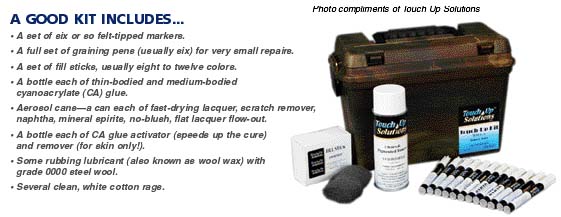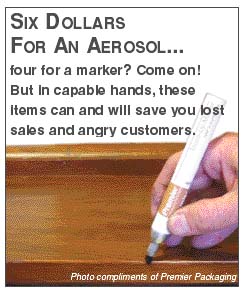Skimping on repair or leaving it in less than capable hands can have dire consequences.
Editor’s Note: For additional information on the ‘Outsource Repair Decision”, see Dan Bolger’s article from the February/March 2002 issue posted to www.furninfo.com in the Marketing Management index.
When you first began selling furniture on a retail level you thought it would be fun, right? After all, when you were working for the big guy down the street, your head would swim with ideas about what you would do better, how you would take the market by storm. And you did! Eventually, though, you realized that as your business blossomed, so did your headaches.
As furniture retailers grow, most find themselves asking the question, “Who’s gonna fix all this stuff?” Third party and in-home repairs can be very costly. They can kill any profit you hoped to make on a sale. Even in-house operations, poorly managed, can drain your budget dry if you’re not careful.

These situations can usually be avoided with the proper planning and equipment. A general rule of thumb: Skimp on repair and you’ll end up regretting it. Some store owners would rather ignore the unpleasantries of repair, leaving it up to a fellow who says he knows how, but really doesn’t. As a shop owner, I can empathize with your reluctance to spend money on repair materials. Six dollars for an aerosol; three for a fill stick; four for a marker? Come on! But in capable hands, these repair items can and will save you from lost sales, angry customers and maybe even the profitability of your business.
One of the worst places to short-change yourself is on the delivery truck. The last chance you have to make everything right is on the edge of that truck bed. So why do so many retailers send their drivers to war without a gun, so to speak? Let’s face it, quality isn’t “job one” anymore, it’s quantity, and we all know that the two are inversely related. With imports bringing new problems to the forefront, if your deluxing isn’t what it should be, then the success of an entire sale can boil down to the preparation and skill of your driver.
So what’s in your driver kits? Do you even have driver kits? I have seen businesses whose front end, the sales end, looks spectacular, but whose back end, the warehouse, is abysmal. Expensive dining tables used as work benches. Damaged goods stacked one on top of another. RTV’s simply pushed aside, to be dealt with “another day.” How many of these problems could have been solved if the driver had the right equipment on his truck? Customers refuse furniture for some pretty basic reasons, among them: Raw (unfinished) edges; surface scratches; splits or cracks; open joints; chips out of the wood; loose parts or pieces; shiny, or dull spots.

With the right components in an intelligently-designed repair kit, in most circumstances, every one of these problems can be corrected. Of course, any kit is only as good as the person using it, so driver training by a qualified repair professional is a must. Begin with what makes the most sense according to your operation. For example, touch-up suppliers love to sell their wares in kit form—that is, they will bundle twelve marker colors together into a kit, or eighty fill sticks. However, a lot of these items go unused. Look closely at your product selection. Do you have a lot of blond woods? Sell a lot of red mahogany? If not, don’t waste your money on generic kits that offer colors you don’t sell. Worse, when the wrong touch-up is used on the wrong finish—such as cordovan mahogany on brown cherry—the result is downright awful.
A good kit will have a tight selection of materials. A driver only has a few minutes to take care of a problem, so loading him up with a lot of possibilities will only confuse him or provide him with something that could make the situation a whole lot worse. A list of basic touch-up kit supplies are listed above.
With these components, a driver, well—trained, can repair every one of the damages, mentioned earlier. Now, obviously, if the damages are excessive or the problem is truly worthy of an RTV, then a more appropriate action is recommended.
Given the prices of these materials, it is particularly unpleasant to have to restock a driver’s kit. There are three main reasons to have to do so:
Improper storage: Touch-up is very volatile (evaporative) and needs to be stored properly. Caps are included with pens for a reason; use them! Heat excites solvents and causes them to evaporate more quickly, and can rapidly dry up cyanoacrylate (CA, or super-) glue and its activator in a single day.
Theft: Unfortunately some drivers will sell or give away their touch-up supplies to homeowners. Almost every touch-up supplier sells “customer service kits” with a small assortment included that you can opt to send out should a customer request it.
Forgetfulness: Touch-up is sometimes forgotten in the panic to get a repair done while the customer isn’t looking, and can be left behind.
Markers last a long time when properly stored, and it can take weeks or months to use up a fill stick. Use a nice-looking case for the materials, kept in the cab of the truck during deliveries and stored inside at night to get the most longevity out of the materials. It can be a poor practice to charge drivers for lost touch-up materials. Abuses do, however, take place and spreadsheets can be used to track usage and are a precise tool to be used in weeding out abusive or negligent drivers.
Admittedly, repair shops can be money pits. I remember managing a shop for a retailer whose touch-up product selection featured just about one of everything—for several different touch-up manufacturers. This duplicity was clearly costing him a fortune. Worse, there was no inventory-taking of the products, so shop people would simply guess when they gave an order. The result was a huge overload of stock that probably took years to deplete.
ORDERING DO’S AND DONT’S
Order by function, not price: Some markers may be really inexpensive but are they the right marker for the job? Ask your repair staff what they need, rather than guessing.
Test products before committing: This is especially true for new shops. Get one each of their best-selling dye toner, pigment toner and clear. Compare and contrast your selection. The right mix is usually a combination of several different suppliers.
Factor in shipping: While some suppliers may offer you great deals on quantities, beware of certain pitfalls such as minimum order requirements and flat-rate shipping. Mohawk’s published price list specifies a minimum $85 order and at least $20 to ship it.
Factor in location: Where is the supplier located? Mohawk is in Hickory, North Carolina while Premier Packaging is in the Chicago area. Should you put all your eggs in one basket if the ship time is seven to ten days? This should also make you re-think how you order, and how often.
It can be useful to create a consortium among the shop people to whittle down the assortment to a managed list of items that are used over and over, on a regular basis. Then, remove all of the items that are clearly duds from the cabinets, and organize the shelves to represent only those items you intend to keep. Generate a label for each item, just like a retail store’s shelf, and arrange the items first by manufacturer, then by application (lacquers, pigments, dyes, etc.), then numerically by item number. For example: Mohawk Finishing > Pigmented toner > 101-0143 (Raw umber).
The labels should have all of the necessary ordering information, making reordering easy. Then set order quantities for each item to prevent over and under-ordering. For example, shops usually use a lot of sanding sealer, so make sure that you order enough to always have enough on-hand. For oddball colors, you might just need a can or two. Labels are easily formatted on a computer; wipe the shelves with naphtha first to remove grease and dirt, so the labels will stick.
Reps can present special problems too, using emotion and sales tactics to persuade shop managers to order excessive product, new items with little or no merit, or duplicitous stock. A perfect example: Just because twelve of something is cheaper doesn’t mean you need twelve. Every can sitting on a shelf represents dollars that could be used to invest in other areas of your operation. Restrict supply purchasing duties to one trusted individual. In time, this person will develop an excellent feel for how much your shop uses. He or she will also become skilled at working with supplier reps and be able to purchase exactly the supplies you need.
Given the fact that most shop people are skilled craftsmen, they expect to be treated as such. With this in mind, when they do ask about a new product, use the following basic criteria to evaluate their idea:
Determine the need: Is there a void that the new product can fill? If so, what is the relationship between the cost of the item and the money it will eventually save?
Assess the mood: Will everyone use it? Or is it a pet project? Will this person be willing to teach everyone to use it, should they ask?
Get a consensus: Ask the group what they feel about the new product. More often than not, a group will shoot down something they feel is superfluous.
Repair is an unfortunate necessity of having a retail furniture store. But a shop needn’t be a gaping black hole into which you shovel your bottom line. Shops need structure. They need control. They need care and attention just like any aspect of your business. A well-run, clean, safe shop is a real asset to any store owner, and it really doesn’t take long to pay for itself.
Touch up sources used by the author
Touch-Up Solutions, Hildebran, North Carolina, tel: 877-346-4747, fax 828-304-0316; www.touchupsolutions.com
Mohawk Finishing, Hickory, North Carolina, tel: 888-3MOHAWK, fax 800-721-1545.
Premier Packaging, Mokena, Illinois, tel: 815-469-7951, fax 815-469-8047.